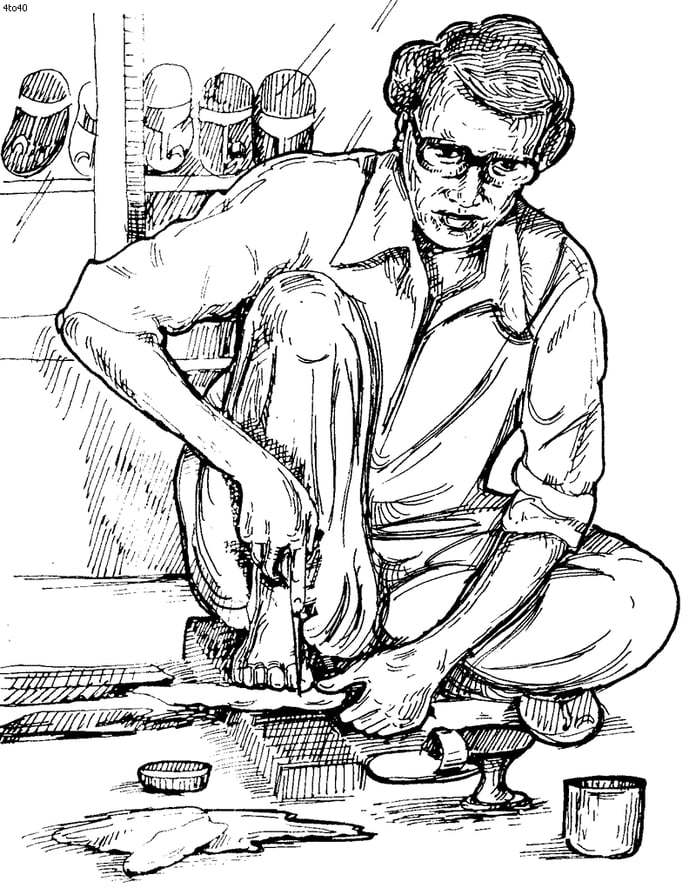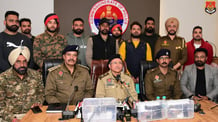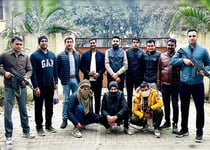
The small town where the days of my childhood , adolescence, youth and middle age were cast is no doubt dear to me. Whenever I look back into the period of my childhood days, some figures figure prominently in my mind’s eye. Their contours of face , their simple and rustic attire, their innocent and down to earth dedication to their small but honourable means of livelihood , and their way of dealing with customers remained etched in my not-so- feeble memory till today .
To begin with , I reverse the order of the title of this piece.
Chhabriwallahs were a common sight in those days as are rehriwallahs (hawkers selling on push-carts) today. A ‘Chhabri’ is a flat wicker basket.
At a corner of the road from where I passed daily , an old man in his sixties, slightly bent , with wrinkled face and sunken eyes, clad in white dhoti and kurta and with a small turban on his head and a white towel over his shoulders , sat on his haunches putting before him his twin chhabris that displayed his merchandise meant for children in particular . In one of his chhabris , he put yet even smaller baskets containing puffed rice flakes (phulliyan…as they are called in Punjab or murmure or murhi in some other Indian languages), ‘daal’___skinless and split grams roasted with a pinch of salt and turmeric __, roasted whole grams, meethi saunf ( sugar coated fennel), and some assortment of toffees and sweet tablets of orange and mango flavour, while in the other chhabri, he put small bags or sacks containing the bulk of his merchandise from which he refilled the smaller baskets. This old man, whose name we didn’t know, but we used to call him ‘babaji’—a respectful epithet for old people— came in the morning carrying his chhabris in a ‘wehangi’___ a country device in which the chhabris are tied in a triangular shape to the each end of a flat bamboo shaft with ropes___ and sat in his fixed place . Then slowly and neatly, he put his items in the samller baskets. I never heard him calling out to attract their attention of customers. From morning till sunset he conducted his business . When the shadows started lengthening, babaji would carry his wehengi on his shoulder and wended his way homewards . He was very punctual in his arrivals at and departures from his business site. In those days, our pocket money was just a five or ten paisa coin but not daily , only once or twice a week. I and Ibrahim–my friend and neighbour –would rush to him in the evenings or in the mornings during holidays and shell out our treasure of ten paisa coin to buy puffed rice flakes and daal. The babaji would put the items in a paper and give to us. We used to mix both the items and relished them munching and talking a great deal about nothing. The combination of daal and phulliyan gave such a wonderful taste that even today my mouth waters just by imagining those things. We were his regular customers till we reached 5th standard. Thereafter , babaji’s visits slowly petered out and a day came after which he was no longer to be seen . Age might have prevailed over him . May his soul rest in peace !
Those were the days when cobblers or shoe menders or repairers were ubiquitous. At every nook or corner of a street , one could see a man squatting on a ‘taat’ ( mat made of jute) or ‘boriya’____( old gunny or jute bag) and mending shoes. People would not discard their shoes until they attained beyond-repair status. I too followed the same rule –courtesy our feeble financial condition. A single pair of hawai chappals were the sole possession of our feet. It was repaired and mended umpteen times. Whenever the strap of the chappals got snapped, I went to the cobbler dragging my feet along wearing the same torn slippers . When the straps could no longer bear the pain of the awl, a new strap was brought and the slippers again bore a new look . Thus mending and changing the strap a number of times , finally a day would come when the soles of the slippers became unequal to the exertions of friction on the roads, and they would be discarded for good. The cobbler I often visited for minor or major operations of my chappals, sat on the side of a street close to the Chhabriwalla about whom I have mentioned above. There was another cobbler sitting just a few yards away from him. Some said they were real brothers , others said they were cousins . Anyway, by face, it seemed they were closely related . Both were in their late sixties or early seventies. One of them was known as Gharibu mochi. They came from a nearby village . As they couldn’t carry their tools and other paraphernalia daily from home to work place and then back home, they would keep their tools and other things in a shop lying close to their workplace . The permanent shopkeepers were kind enough to oblige them without levying any charges on them for the service they rendered. These two cobblers dressed in traditional rural dhoti and kurta would come there at seven in the morning during summers and at nine during winters. They would take their bags from their respective patrons, clean the place with a broom, spread an old gunny bag , take out and arrange their tools which included a cobbler’s anvil or tripod, an awl, a gourd, a skewer, pliers, scissors, a knife, a hammer, thread and needle, nails, leather hole punch etc. By their side in a bag, they kept some old and new strips of leather, old shoes and chappals. Both were experts in their trade and consequently there existed a strong professional rivalry between them . They would keep an eye on the customers whether they came first to him or the other. People used to visit the one who was not very busy to get their work done at the earliest. These two cobblers would behave coldly with a customer who approached the other one first . Professional rivalry made them indulge in backbiting sometimes as they disclosed the faulty skills of each other to the customers…..that the other one uses a thread of low quality , he does not sew the broken part properly, he makes stitches with wide gaps etc. I used to get my chappals mended by Gharibu . He spoke with a nasal sound. He would examine the patient chappal, and then after thinking for a while , tell the cost of repair . If the customer agreed , he would proceed with the repair work. The charges depended upon the disease and illness of the patient. Normally, for a single repair without using a piece of leather for a patch ranged between 10 to 25 paise . In that too people bargained with him to cut down the cost. And sometimes he did relent to waive off 5 paise. He also used to shine the shoes . For that he kept with him a variety of creams , polish and some black powder to give extra shine and gloss to the shoes. Indeed, shoes polished by him lent a mirror shine to them . He would say ‘ tusi apna munh waikh sakde ho .iddan di palsh kiti ae main’….You can look your face in the shoes . I have shined them such.
As years passed by, I saw less of these two tradesmen. Gharibu was the first to have stopped coming to the spot. And a few months later, the other cobbler was also no longer to be seen . All their toil and trouble was to oil the machine of their life. Now they might be feeling in heaven that someone is writing about them. Rest in peace !
And last but not the least is an itinerant barber who roamed our streets to catch his customers. Tall and lanky, immaculately clean shaven, dressed in white dhoti and kurta, with his tool box tucked in his armpit, walking with a graceful gait as if ascending a hill.and smoking a ‘biri’ Bhagta Nai , as he was popularly called, trod the streets of our town especially on Fridays and Sundays. His clean-shaven face was a manifest proof of his professional skill. He was in his late fifties .He was very innocent , simple and rustic, and perhaps not initiated into the world of trickery. He spoke with a shaky voice. People used to make fun of his naivety. It is the way of the world to ridicule anybody who looks innocent, simple or gullible. His charges, in those days, for a haircut were 30 paise. For shaving , he took 25 paise. He also offered a discount of 5 paise if one opted for both a hair cut and a shave. For making a ‘tind’– tonsuring the head completely–he took 25 paise. Because of his low charges, parents insisted that their children should have a hair cut by him.
In his tool box he kept , a couple of scissors, combs , manual trimmer, a straight razor, a packet of blades, a small mirror, shaving brush and cream, a piece of alum, a slab of whetstone, a pair of towels, a powder-tin and a brush for dusting pieces of hair.
Bhagta ji was so innocent that he didn’t even know that Odisha is in India. Once when someone taunted him that his tools have become worn out, blunt and old, he retorted, ” Ae wekh ustra ..made in Odisa’…(see this razor, it is made in Odisha) and displaying the razor in his hand he asked him to feel the sharp edge of it.
People took him home for benefitting from his services. Specially, elderly men liked him . Barbers are blessed with the gift of the gab. They are naturally very talkative and garrulous. During the haircut , one could listen to the entire happenings of the town or village from politics to love affairs . Bhagta was no exception to this . He was also fully loaded with all such stuff and would pour out this treasure of gossip on to his customers. Listening to his stories was like music for his customers as it would make their sitting comfortable and cosy for the otherwise boring procedure of a haircut. Although my parents never hired him for my hair cut , yet I watched him closely serving others and even talked to him a couple of times. Some years later, he was no longer seen in our area. Maybe he had shifted to some other town. But, one day, I learnt that he passed into eternity. Using his sharp edged razor as an oar, he ran his boat of life through the hard waters of the world. In fact , he tried to earn a softer living in a hard world.











